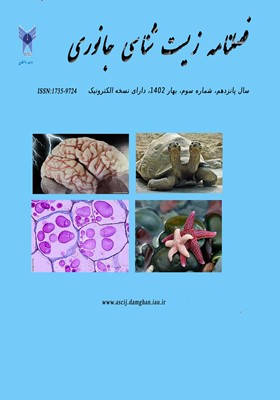اثر نانوکامپوزیت ZnFe2O4@Ag بیوسنتز شده توسط Chlorella vulgaris روی بیان ژنهای CAD، caspase 9 و p53 در ردهی سلولی سرطان پستان
محورهای موضوعی : فصلنامه زیست شناسی جانوری
آیدا محمدعمویی
1
,
وجیهه زرین پور
2
*
![]() ,
سید عطا اله سادات شاندیز
3
,
علی صالح زاده
4
,
سید عطا اله سادات شاندیز
3
,
علی صالح زاده
4
1 - گروه زیستشناسی، واحد دامغان، دانشگاه آزاد اسلامی، دامغان، ایران
2 - گروه زیستشناسی، واحد دامغان، دانشگاه آزاد اسلامی، دامغان، ایران
3 - گروه زیستشناسی، واحد تهران مرکزی، دانشگاه آزاد اسلامی، تهران، ایران
4 - گروه زیستشناسی، واحد رشت، دانشگاه آزاد اسلامی، رشت، ایران
کلید واژه: نانوکامپوزیت, سرطان پستان, آپوپتوز, کاسپاز,
چکیده مقاله :
با توجه به افزایش روزافزون موارد و مرگومیر ناشی از سرطان پستان، استفاده از محصولات نانوفناوری در درمان این بیماری مورد توجه محققین قرار گرفته است. این مطالعه با هدف ساختن نانوکامپوزیت ZnFe2O4@Ag با استفاده از عصاره جلبک Chlorella vulgaris، ارزیابی اثرات ضدسرطانی آن بر ردهی سلولی سرطان پستان و همچنین بررسی اثرات نانوکامپوزیت ساخته شده بر بیان ژنهای مؤثر در آپوپتوز انجام پذیرفت. اثرات ضدسرطانی ZnFe2O4@Ag و دوز نیمه کشنده آن برای سلولهای MCF-7 با استفاده از آزمایش MTT تعیین شد و از آزمایش Real Time PCR بهمنظور بررسی اثر مواجهه با نانوکامپوزیت مذکور بر بیان نسبی ژنهای p53، caspase 9 و CAD استفاده شد. نتایج نشان داد که در غلظتهای بالاتر از 62/15 میکروگرم بر میلیلیتر، نانوکامپوزیت ZnFe2O4@Ag سبب کاهش معنیدار زندهمانی سلولهای سرطان پستان شد و دوز نیمه کشنده آن 28 میکروگرم/میلیلیتر تعیین گردید. همچنین، نتایج آزمایش real time PCR نشان داد که مواجهه با نانوکامپوزیت سبب افزایش معنیدار ژنهای p53، caspase 9 و CAD به میزان به ترتیب 22/2، 98/1 و 96/5 برابر گردید. به نظر میرسد که نانوکامپوزیت ZnFe2O4@Ag به دلیل دارا بودن عناصر نقره و روی، با افزایش تولید رادیکالهای آزاد اکسیژن سبب آسیب به اجزای سلولهای سرطانی شده که متعاقباً باعث القاء آپوپتوز و مرگ سلولی خواهد شد.
Regarding the increasing trend of the morbidity and mortality of breast cancer, the use of nanotechnology products in breast cancer treatment has gained interest. The current work aims to synthesize ZnFe2O4@Ag nanocomposite using the Chlorella vulgaris extract, assessment of its anticancer potential on breast cancer cells, and evaluate the effect of the nanocomposite on the expression of apoptotic genes. Anticancer potential and lethal dose 50% (IC50) of ZnFe2O4@Ag were determined using the MTT assay and real-time PCR was employed to evaluate the expression of p53, caspase 9, and CAD genes. According to the results, at concentrations greater than 15.62 µg/mL, ZnFe2O4@Ag considerably decreased the viability of breast cancer cells and IC50 was determined 28µg/mL. Moreover, the relative expression of the p53, caspase 9, and CAD genes was significantly increased by 2.22, 1.98, and 5.96 folds, respectively after exposure to the nanocomposite. Owing to the presence of silver and zinc, it seems that ZnFe2O4@Ag generates reactive oxygen species that could damage cell components and subsequently induce cell apoptosis.
_||_

